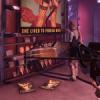Our favorite games have almost a messianic quality to them. We love to replay a handful of our favorites over and over (when our editors give us the time, at least), finding new depths to explore, and new meanings to ponder over. Sadly, a lot of the games we pin our hopes on just never materialize (I’m looking at you, Beyond Good and Evil 2). And that’s a shame, because with the development cycle of games getting longer and longer in the industry, occasionally we have to wait years for even the slightest bit of news.
This is a list of the games that beat the odds—the ones that clawed their way back from the ninth circle of development hell, and became some of the most influential titles in the industry.
5. S.T.A.L.K.E.R: Shadow of Chernobyl
Stalker: Shadow of Chernobyl is far from a perfect game. Upon its release it was buggy as hell, crashed every other time you went to play it, and by the time it was released in 2007 the graphics looked pretty dated to boot. Add to that the game’s bizarre English dubbing over from the GSC Gameworld’s native Ukrainian, and you’d be excused from wondering how it made this list in the first place.
But look past some of the more egregious bugs, and Stalker reveals itself as a fairly innovative shooter. It’s an incredibly bleak game with a highly oppressive atmosphere, to be sure—probably the closest we’ll come to playing a video game of Cormac McCarthy’s The Road (decide for yourself if that’s a good thing)—but it also lends itself to the obsessive compulsive gamer.
Surviving the wastes and completing your objectives in Stalker becomes a full-time job with little time for respite. Firefights are full-on mental chess matches, not simply because your enemies are so persistent and merciless (you’ll sometimes kill 2 soldiers only to be overwhelmed by a pack of rabid dogs), but because the game constantly forces you to measure out your ammo and rations.
Despite its hipster-cred (obscure Ukrainian shooter set in the bleakest vision of a radioactive wasteland imaginable? Check.), Stalker is still one of the hardest games we’ve played.
Strange then, that it took so long to finally show up. Stalker: Shadow of Chernobyl was originally announced back in 2003. At the time, it was billed alongside Crytek’s original Far Cry as heralding the next generation of PC games. To put that in perspective, I remember first reading about Stalker on the America’s Army forums. Gee, remember that one?
A bit like Far Cry 2, many at the time considered Stalker to be too ambitious. Open-world games had enjoyed some success in RPGs before, such as Bethesda’s Morrowind, but the genre had not really carried over to first-person-shooters yet. The concept of an open-world survival-horror title was intriguing, but even the idea of a dynamic day/night cycle (one of Stalker’s selling points was that players would be vulnerable to monsters’ attacks at night) was revolutionary at the time - as was it’s much-lauded A-Life system, which promised a living ecosystem.
Years of delays later, and we finally did get a chance to play Stalker: Shadow of Chernobyl after all. Was it perfect? No, and many of the features originally promised were absent. But there were some compelling elements that made it stand out from the other shooters on the market. In some respects, it was a time capsule—the type of game that got buried after the 1990’s run of artsy games made by small-studios on shoestring budgets. In our humble opinion, it deserves its place on this list purely for being so often overlooked.
4. Fallout 3
The development of Fallout 3 is the story of a game that simply could not die. The original Fallout, developed by Black Isle Studios, debuted back in 1997, with a sequel released the following year. After that, there were two spin-off games produced by Micro Norte and Interplay, with a third edition to the main storyline in development by Black Isle, codenamed Van Buren.
Then Black Isle Studios went under.
In the yard-sale that followed, Bethesda Studios bought the rights to the next Fallout title. Already hard at work on the Elder Scrolls series, Bethesda threw out the code from Black Isle and rebuilt the entire game from scratch using the same game engine that powered The Elder Scrolls IV: Oblivion.
Despite creating a game so far removed from its predecessors, Bethesda’s gamble paid off. Fallout 3 picked up favorable reviews, enjoyed widespread popularity (to say nothing of the enthusiastic modding community that followed shortly after), and continued to grow with some pretty hefty DLC packs, and spawning a follow-up: Fallout: New Vegas.
Purists will perhaps argue that Bethesda strayed too far from the original series. After all, Fallout was originally a top-down RPG with turn-based combat. Fallout 3 threw all that out with real-time first-person gunplay, alongside a slow-motion “tactical” combat system that allows you to freeze time and target specific body parts of your enemies. And it’s true, playing Fallout 3 can occasionally feel like a grand mix of game genres—a little first person shooter, a bit of RPG XP and leveling, a touch of turn-based combat, and a healthy dose of sandbox exploration. Playing it like any other shooter can be frustrating, but for those who invest in its quirks, Bethesda’s take on the Fallout series was well worth the wait.
3. Bioshock Infinite
It’s rare (if sadly not unheard of) for an established game studio to collapse less than a year after releasing a AAA title. After the success of 2007’s Bioshock, the developers at Irrational Games went quiet, and began furiously working on the game’s follow up. Ultimately, the project that would become Bioshock Infinite would rack up enormous costs, though creative director Ken Levine flatly denied that the game cost $200 million to produce and market, as the New York Times speculated at the time of Infinite’s release.
Though the exact cost may never be known, the third installment in the Bioshock franchise (only the second from Irrational Games, Bioshock 2 was produced by another studio) was plagued by development drag from the start. The team at Irrational originally envisioned the flying city of Columbia draped in storm clouds, not wholly dissimilar from the dreary undersea world of Rapture. Indeed, the original conflict was to be between Technologists and Luddites, rather than between religious followers of Father Comstock and a fiery brand of black and Irish Anarchists. There was also originally going to be a multiplayer mode, but that was ditched late into development.
Early footage of gameplay shows that even more changes were made further along in the game’s development. In a demo shown back in 2010, Elizabeth’s alternate-dimension “tear” powers are absent, but she possessed instead what appear to be extremely powerful telepathic powers. She also takes an active role in combat. Much of that was changed by the time of the game’s release three years later.
Whatever the changes, Bioshock Infinite took six years to complete, something that is hard to overlook in the fickle, big-money world of video game publishing. Three months prior to the game’s release, Wired ran a profile in which they pointed to “…concern that [Infinite] may well be a troubled game—one that instead of showing a way forward for the medium will be remembered forever as an example of What Not to Do.” In the end, neither outcome really occurred. Bioshock Infinite was simply a solid game, one with no more or fewer flaws than any other big-budget title.
Despite huge critical and commercial success, Infinite wasn’t enough to save the studio. In February 2014, studio head Ken Levine announced that the developer would be closing down, with 15 staff joining Levine to make smaller, narrative-focused games for publisher Take Two Games. In its 15-year history, Irrational didn’t put out a single dud title. System Shock 2 is considered by many to be one of the best games ever made, Freedom Force took squad-based strategy and layered with superheroes and a retro-comic book aesthetic, and SWAT 4 revitalized a series that many had considered dead. But it is the Bioshock series which they will be most remembered for, and the loss of the studio is a sad one.
Irrational Games, you will be missed.
2. The Legend of Zelda: The Wind Waker
Few games have presented such a radical and abrupt change in artistic direction as the development of The Legend of Zelda: The Wind Waker.
Originally, Nintendo’s development team presented the next Zelda title with a darker, more life-like vision of Link (which would later go on to inspire Twilight Princess). In 2000, they presented a tech demo of Link battling Ganondorf at the Space World convention, which was met with praise from both critics and fans for taking Zelda in a more serious direction.
Within a year, however, the game’s art direction and visuals completely changed to a cel-shaded theme. Where Link was once a photo-realistic character, The Wind Waker would make him into something like a cartoon. The backlash from fans was almost immediate.
The game’s fortunes were intrinsically tied to the development of Nintendo’s Gamecube console. As the Gamecube was geared towards a family-friendly image, arguably the Zelda development team wanted to follow Nintendo’s direction. The Legend of Zelda: The Wind Waker was released in its updated, cel-shaded model… and instantly became a beloved classic of the series. Twilight Princess returned to a more somber artistic direction, but the Wind Waker’s art-style stuck and has since been re-used across a number of subsequent handheld titles. The Wind Waker’s artistic influence can also be felt in the Wii’s Skyward Sword and the upcoming Wii U installment in the series, which both opt for a more vibrant, colorful palette.
In the end, was The Wind Waker really almost vaporware, or would it be more accurate to describe Nintendo’s original, darker vision of Link’s journey as a game lost in development? It’s hard to say, but despite the initial scepticism The Wind Waker garnered Nintendo a whole new host of Zelda fans. In spite of the arguably lost vision of Zelda, The Wind Waker retains a solid fan-base of players - as evidenced by the game’s hugely successful re-release on the WiiU.
1. Half-Life
It should come as a surprise to no one that Half Life made this list. Valve’s habit of announcing their next big game, then keeping silent on any further developments has made the Washington-based studio legendary in the gaming industry. The repeated delay of Half Life 2: Episode 3 has even generated its own meme.
What’s less well known is that the first Half Life—the game that really put Valve on the map to begin with—almost never materialized at all.
Originally begun in 1996, Half Life was not released until November of 1998. Most of our younger readers will probably scoff at that, since we’ve long since become accustomed to waiting two years for a game to make it onto the shelves. But you have to remember the time in which Half Life was made.
The mid-1990’s were probably the most innovative and cutthroat time to be a game developer that we’re likely to see in our lifetime. The dot-com boom was in full swing, and a personal computer was all of a sudden something you had to have for work as well as entertainment. Games, for the first time, were coming out of the garage and seedy arcade halls to take center-stage on your own home computer. It’s not surprising then that developers often had the egos and personalities to match - like when we were promised that Daikatana developer John Romero was going to “Make you his bitch.” Some of those guys are still around: Cliff Blezinski and Ken Levine both got their start in the heady rush of the 1990’s.
Into this smorgasbord of mad-money and fly-by-nights strolls Valve, a company that had never before produced a game, who now presented an ambitious project many thought couldn’t be pulled off. Running on a heavily modified version of the original Quake engine, Half-Life seemed like it would be a classic case of a game developer biting off more than it could chew - there were simply too many new features (Valve’s development team built skeletal animation into the Quake engine for Half Life). If even one element of the tightly-scripted game had fallen through (say, if the enemy AI had been less tenacious), Half Life as we know it wouldn’t have been possible. But after long delays and repeated occasions of going back to the drawing board (it’s notable that the shareware demo, Half-Life: Uplink bears little resemblance to the final game), Valve finally introduced the world to Gordon Freeman, and the world went nuts.
Against all odds, Valve pulled it off and produced a game which still regularly tops lists of the best games ever made. The rest, as they say, is history.








